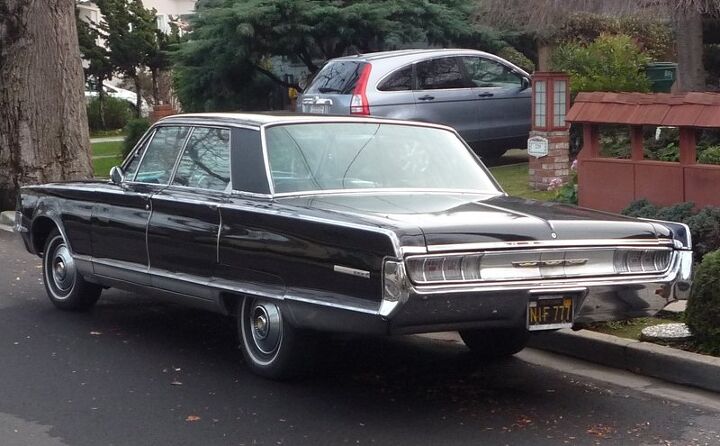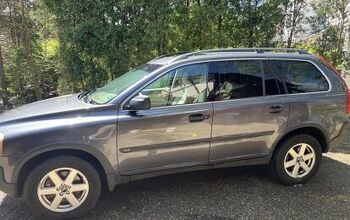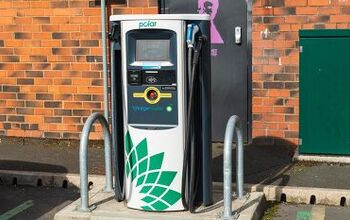Curbside Classic CA Vacation Edition: 1965 Chrysler New Yorker

Why exactly does this car create such a powerful response (in me, anyway)? It projects such solidity, dignity, and self-assurance. It flew in the face of GM’s 1965 coke-bottle styling, and showed that hard-edged angularity still had some serious life in it. Most of all though, this Chrysler New Yorker represents a pinnacle: never again would the New Yorker attain this degree of success, prestige and quality.
The Virgil Exner years at Chrysler were a styling roller-coaster ride. He resurrected Chrysler from the stodgy, boxy K.T. Keller years and set it on the path toward styling leadership with the radical ’57 models. But he took the hit for the strange 1962 models, and his Exneruberance was a bit too wild or overdone at times, like his persistence in grafting fake-spare tire covers on the trunks of everything from Valiants to Imperials. By 1961, too much of Chrysler’s sales woes were blamed on Ex, and it was time to exit.
Elwood Engel was recruited from Ford, where he was credited with the mile stone 1961 Lincoln. It’s angularity and compact elegance laughed in the face of the over-wrought finned Caddys. Engel brought a radical change in styling direction to Chrysler, and in its first few years, like so many new starts, it worked like a charm.
The first sign of the new direction was manifest in the very T-Birdish Turbine Car of 1963. It took a few more years for Engle’s angularity to come to full fruition at Chrysler, and it arrived just as GM was heading the opposite direction. And Ford was chasing the Pontiac look. Eventually, it led Chrysler into a dead end, and the radically different fuselage Chryslers of 1969 were seen to be the way out. It wasn’t, despite their strangely appealing qualities. By 1974, Chrysler was back to a boxier, edgier look, hoping to recapture the success of the ’65 – ’66 models, without avail.
One of the first Curbside Classics was a ratty, rusty 1965 Chrysler Newport coupe. This stately New Yorker that I found on a walk in Millbrae is every bit its opposite: a remarkably superb car to be sitting out front. I could practically feel its presence over a block away, standing out among the curvaceous little cars around it like the Chrysler Building in a trailer park.
These Chryslers were some of the best built cars carrying that name since its WWII tanks, and the passenger tanks it built just after the wa r. The unibody was tight, the torsion-bar suspension lacked the floaty feel of its competitors, and interior and trim quality would never again be this solid. But don’t be fooled into thinking this barge was overly heavy: at 4,295 lbs, it weighed exactly the same as a “compact” 2009 Saturn Vue. With 340 horses (gross) on tap from its 413 CI V8, these Chryslers hustled down the road effortlessly. Brakes were better than average for the times, and the Torqueflite tranny was best in class. Chrysler’s numb power steering was the only fly in the ointment, but for its intended purpose, who cared?
Chryslers appealed to buyers who still felt that a finer engineered car was the one to buy. There were several relatives and University acquaintances for whom these vintage Chryslers were the last American cars they ever bought; they all drove Mercedes by the mid seventies. Now that I think of it, that’s the reason why I hold these Chryslers in such high esteem: they really were the end of the road in more ways than one for Chrysler.

More by Paul Niedermeyer
Latest Car Reviews
Read moreLatest Product Reviews
Read moreRecent Comments
- Theflyersfan This system would be in total overload from Washington, DC/NoVA all of the way to Boston, because it seems that every driver in that area is having some form of a bad day to a total psychotic meltdown. What's HAL9000 doing to do, recline the driver's seat, put some kind of aroma candle scent through the vents, turn on the massage seat, and give you some kind of "Demolition Man" YOU FEEL GREAT TODAY platitudes on the infotainment screen?
- SCE to AUX The dealers could easily get away with two Level 2 chargers and one or two Level 3 chargers at most.Ford has bungled this from the beginning.
- Theflyersfan Ford, it's simple. If you want to continue to only sell EVs that have some serious quality issues and are over $60,000, you aren't going to need to make many changes and add extra chargers and the such because you aren't going to sell that many.However, if they somehow come up with a plan and sell an EV that has all of the issues and bugs figured out, decent range, and comes in around the national average of $40-$45,000, then start installing chargers because they might just sell a few. But as all of the Ford articles have been showing lately, there's rot at all levels of the chain there so good luck guys.
- Carson D Ford: Built by the Model T. Killed by the Model e.
- Bd2 Mary Mary Mary Barra!







































Comments
Join the conversation
First car I drove was my dad's gold on gold 65 New Yorker 4 door hardtop - identical to this one other than color. Loaded with every option but a/c - not really needed in Buffalo! That 413 4bbl was a monster and it was solid as a tank, but steering was super light and twitchy. One feature I thought neat at the time was the fender mounted turn signal indicators - those small chrome darts on top of the leading edge of the front fenders. Dad was a Chrysler man as far back as I recall beginning with Dodges (48 & 52) and moving up to Chryslers with a 55 Windsor and 59 Saratoga (with swivel buckets!) sedans. Moved up again to New Yorker sedans in 61 & 63, and finally hardtops in 65 & 67 (next best thing to a 2 door or convertible for a teenage wannabe motorhead). Believe the 65 cost @ $4600 and the 67 @ $4800. He retired and "downsized" to a couple of late-60s Fury IIIs before passing on. I actually think Chrysler has begun to recapture that mid-60s feel with the RWD/AWD 300s, but time will tell.
The advertising literature of 1965 Chryslers said it best: The Most Beautiful Chrysler Ever Built." The cars are long, lean, and distinguished. The New Yorker grill of 1965 is most beautiful. The interior door handles on the New Yorker are clever. The speedometer design is elegant. The car moves quickly, with ease. I've owned two '65 New Yorkers in my life and my current one is an ice blue 4 door hardtop that I intend to keep for years to come. You can take your Caddys from '65, and the Lincolns, too. The Chryslers of '65 have the most distinguished, lean, and yet solid look by far.